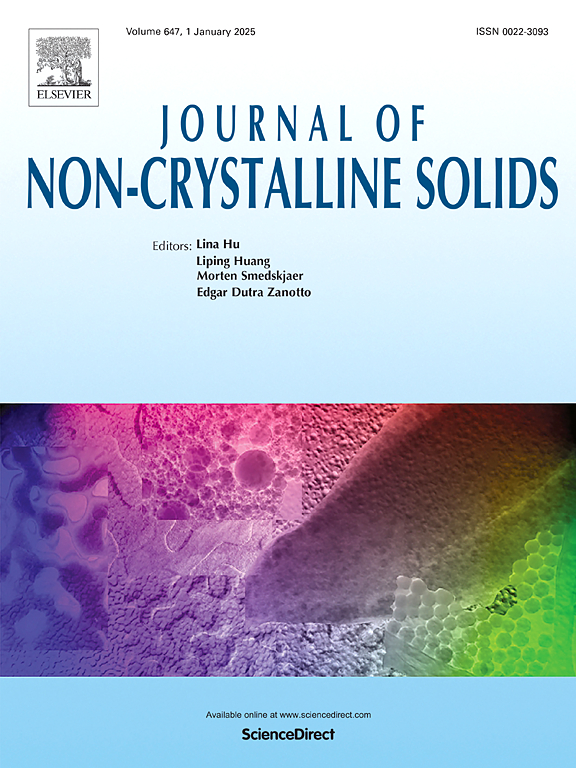Determination of critical nucleus radius in oxyfluoride glass via molecular dynamics simulations
IF 3.5
3区 材料科学
Q1 MATERIALS SCIENCE, CERAMICS
引用次数: 0
Abstract
The critical nucleus radius is a fundamental parameter for understanding nucleation kinetics and crystallization behavior. However, in glass-forming oxides, direct observation of nucleation from melts or the growth of nuclei near the critical radius using the seeding approach has not been achieved in molecular dynamics (MD) simulations. In this study, we investigated BaF₂–ZnO–B₂O₃ glass, which exhibits an ultrafast nucleation rate. BaF₂ crystalline nuclei of varying radii were embedded within the glass composition, and their stability was monitored at different temperatures by determining whether they grew or dissolved. A linear relationship between temperature and the critical radius was observed, enabling the calculation of interfacial energy using the classical Gibbs approach. The interfacial energy was determined to be γ = 0.144 J/m2, and the critical radius was evaluated to be r* = 0.48 nm at the crystallization onset temperature (823 K). The relatively low interfacial energy, comparable to metals but much lower than oxide glasses, is attributed to the structural affinity between fluoride-rich domains in the glass and the BaF2 crystalline phase. This study demonstrates the applicability of the seeding approach to oxide-based glassy systems and provides one of the first direct computational validations of the critical radius in glasses.
通过分子动力学模拟确定氟化氧玻璃临界核半径
临界核半径是理解成核动力学和结晶行为的基本参数。然而,在形成玻璃的氧化物中,在分子动力学(MD)模拟中,使用播种方法无法直接观察熔体的成核或核在临界半径附近的生长。在这项研究中,我们研究了具有超快成核速率的BaF₂-ZnO-B₂O₃玻璃。将不同半径的BaF₂晶核嵌入到玻璃成分中,并通过测定它们是否生长或溶解来监测它们在不同温度下的稳定性。观察到温度与临界半径之间存在线性关系,可以使用经典的吉布斯方法计算界面能。在结晶起始温度(823 K)下,界面能为γ = 0.144 J/m2,临界半径为r* = 0.48 nm。相对较低的界面能(与金属相当,但远低于氧化物玻璃)归因于玻璃中富氟化物域与BaF2晶相之间的结构亲和力。这项研究证明了播种方法在氧化基玻璃系统中的适用性,并提供了玻璃临界半径的第一个直接计算验证之一。
本文章由计算机程序翻译,如有差异,请以英文原文为准。
求助全文
约1分钟内获得全文
求助全文
来源期刊

Journal of Non-crystalline Solids
工程技术-材料科学:硅酸盐
CiteScore
6.50
自引率
11.40%
发文量
576
审稿时长
35 days
期刊介绍:
The Journal of Non-Crystalline Solids publishes review articles, research papers, and Letters to the Editor on amorphous and glassy materials, including inorganic, organic, polymeric, hybrid and metallic systems. Papers on partially glassy materials, such as glass-ceramics and glass-matrix composites, and papers involving the liquid state are also included in so far as the properties of the liquid are relevant for the formation of the solid.
In all cases the papers must demonstrate both novelty and importance to the field, by way of significant advances in understanding or application of non-crystalline solids; in the case of Letters, a compelling case must also be made for expedited handling.
 求助内容:
求助内容: 应助结果提醒方式:
应助结果提醒方式:


